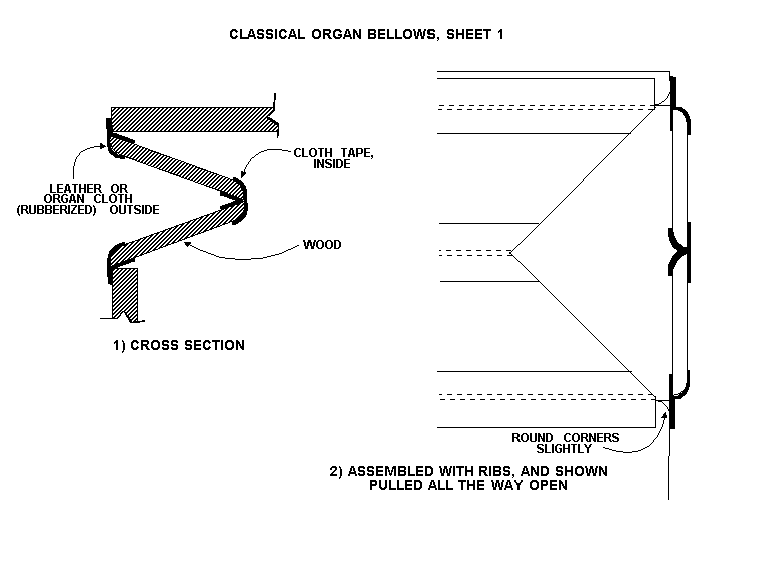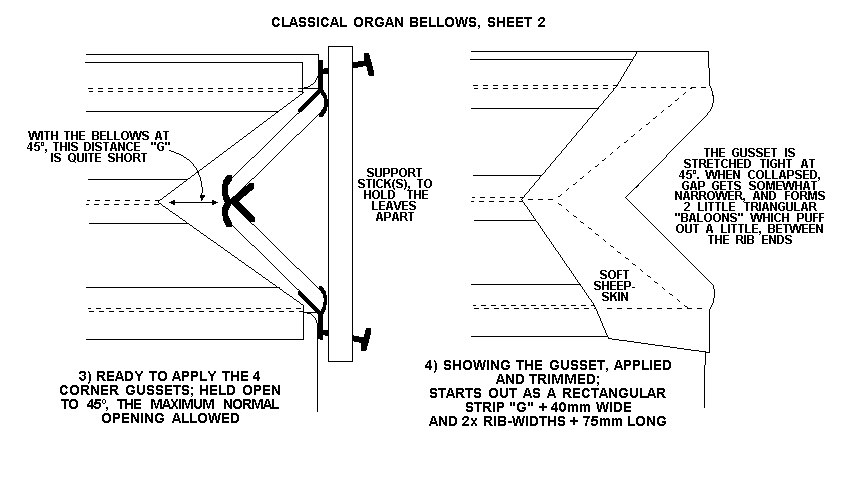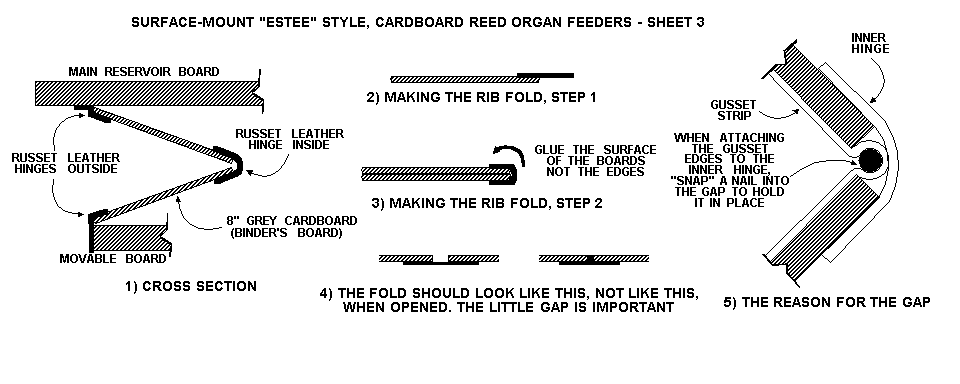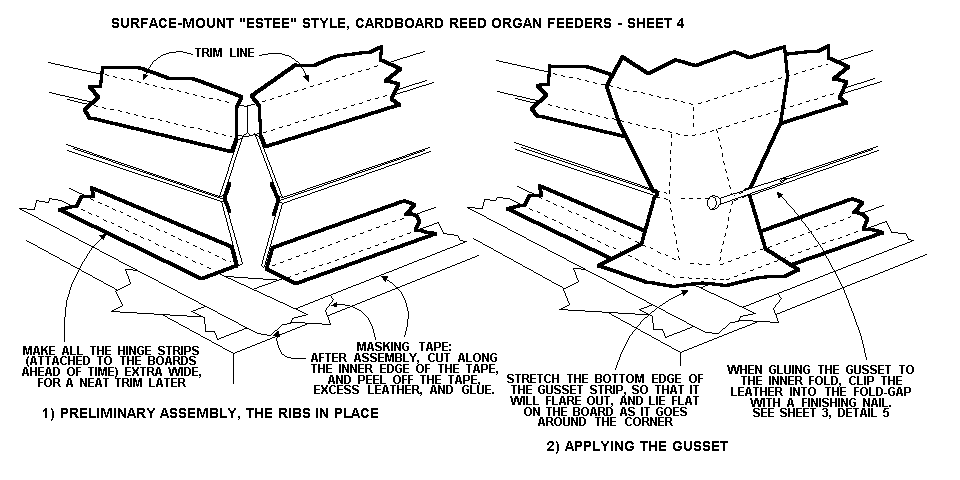| You Are Not Logged In | Login/Get New Account |
|
Please Log In. Accounts are free!
Logged In users are granted additional features including a more current version of the Archives and a simplified process for submitting articles. |
|
MMD
 Tech
Tech
 vanceBellows1
vanceBellows1
|
|
Spring Fundraising Drive In Progress. Please visit our home page to see this and other announcements:
https://www.mmdigest.com Thank you. --Jody
|
|
Classical Organ Style & Estee Reed Organ Style by Richard Vance
There have been many very clever people in the organ building racket for the last 400 years, but they still make bellows the same old way. There must be something to it. I think the reason is that it actually easier to do it this way, in spite of the seeming complexity and numerous pieces involved. Also, it is very forgiving of any dimensional errors in making the chest, lid or ribs. The secret is to use hot glue only. Hot glue is really the best for this, for these reasons: Reason 1: The main reason is that as soon as the glue temperature falls below the 'gel point', it has enough strength to hold everything together. One can move right from one joint to the next, without delay. Of course, one must wait 24 hours for it to get hard enough to the bellows can resist full pressure, but then hot glue grips leather strongly enough to split the leather rather than tear off, if one tries to pull a piece loose. Reason 2: Hot glue will stick to only the surface of the leather, and not saturate it and make it stiff. When the leather encounters the hot liquid glue, the glue tries to soak in. But as soon as the capillaries of glue in the fabric's substance migrate any distance from the mating surface, they are separated from the thermal mass of the glue layer. They cool down immediately to the 'gel' stage, and then are no longer a true liquid, and can not migrate any farther. Modern polymer glues, on the other hand, remain liquid until fully dry; they saturate the leather around the hinge lines, making it stiff there, and providing foreign substance within the fibrous structure which leads to premature breakdown. Reason 3: Hot glue is, paradoxically, the most flexible adhesive there is, even though the dried glue seems to be a hard mass. Some glue is bound to slop over into areas that are supposed to be flexible, like the hinge line between the inner and the outer hinges of larger bellows shown below. But because of its very hardness, it breaks up into a million individual crystals the first time the joint is flexed. These may remain attached to the leather's surface, but do not interfere with anything. The first time you flex the bellows after it has fully dried, you will hear crunch-crunch as this happens, but then everything will move easily. Polymer glues dry to rubbery mass, that remains forever to interfere with the joint's easy movement. The style illustrated is for a big pipe organ, with wooden ribs. For smaller bellows, with ribs less than 50-75 mm wide, like on a reed organ, they usually use 'binder's board' (3-4 mm gray cardboard), with only one layer of leather on the hinge line. I have seen tiny organ pneumatics made from red 'pressboard' (about 0.3-0.5 mm), hinged and gusseted with pouch leather, but made just the same way. In this style of construction, there is no shearing or rolling of the corner gussets. As the bellows closes from 45º to fully closed, the gap between the ends of the ribs becomes narrower. The gusset, flat across this gap at 45º, just bulges out like a pouch when the gap becomes narrower. I have seen very old bellows, where the leather is rotten enough to crumble between the fingers, still be intact here. Tips: 1) Use masking tape to cover areas on the lid, ribs or box not to be glued. I suppose the pros can brush on a neat line of hot glue quickly, but one must work quickly, to brush on the glue and apply the fabric while the glue is still above the 'gel' temperature. The tape allows the amateur to slop it on quickly, and still have a neat looking result. 2) When joining the two ribs at the fold line, first lay them right side-by-side, and apply the inner fold strip. Then fold the pair of ribs together and apply the outer strip if necessary. Otherwise the hinge will bind. 3) Glue the strips forming the top and bottom hinges to the rib pairs only, first. Then fold the rib assemblies, and firmly clamp them where they belong between the top and bottom of the bellows. Then glue the free edges of the hinge strips (first the inner layer then the outer layer, if there are two.) to the edges of the lid or box. This makes sure that the hinge line ends up in the correct place, so when the bellows is opened, the fold line will always end up at the center of the gap. 4) Stretch the edges of the gusset sheepskin strip at its midpoint, by pulling it gently. It will fit better. 5) First glue only the center of each edge of the gusset strip to an area around the fold line of the ribs, and let it gel well. Push the stretched edge into the folds with a stick, and hold them for a minute. 6) Finally glue each of the four remaining corners of the gusset strip individually to the rest of the rib and the lid edge. You have to pull these corners tight, stretching the leather back towards the center of each side, so there will not be a gap at the corner. Only leather will stand the slight stretching needed to form this theoretically impossible 'plane surface', so that is why it is still used, rather than some modern material. 7) For a triangular feeder, there are only two such corners. For the hinge end, just extend the ribs back towards the hinge, until they become impractically narrow. Cover the remaining length with a piece of leather, long enough to lap over the hinge end by 50 mm. Glue this to the sides of the boards while the bellows is open. But wait, and glue on the end that laps over the hinge later, after the bellows is dry enough to be closed; otherwise the hinge will be bound open by the tension in this piece. Some additional tips about "Estee" surface-mounted cardboard bellows: The main difference here is that one side of the feeders are mounted directly to the large fixed board of the reservoir. There is no "edge" of a board or box to hinge one side of the bellows to. The fixed edge of the bellows must be lapped flat to this surface. 1) When removing the old bellows, tear off as much of the old leather as possible. Them wash off the remaining scraps of leather and glue with a wet rag. It takes a while for the glue to soften, but after 20 minutes, the whole mess wipes away. Doing it this way, the old, darkened wood beyond the glued edge keeps its original appearance, rather than being marred by sanding or scraping. The original glue lines show up clearly as lighter strips, and can easily be followed in the new work. 2) Make new ribs, using the old ones as a pattern. The old 'binder's board' or 'cornboard' may look OK, but it tends to split or delaminate, and spoil the job. A good source for 'binder's board' are old PVC covered notebooks or catalogs. Slit the PVC covers, and new squares of binder's board pop out. 3) The old hinge strips were made of russet skivers, like pouch leather, but thicker. A good modern substitute is tan garment suede. It is important that the leather be unfinished on both sides, since both sides have to be able to be glued. Modern shiny leather has a wax or polymer finish on the shiny side, that resists hot glue. 4) The gussets, and the triangular pieces covering the hinge ends, should be real white sheepskin 'gusset leather'. Expensive but worth it. In order to fit properly, especially at the bottom-front corners, the bottom and the center of the edges of the gusset strip must be stretched to add width to these points. Real gusset leather can be stretched by gently but repeatedly tugging the area with the fingers, without tearing. 5) Define the area on the main board to be glued, with masking tape. Make the strips on the edges of the ribs wider than the final dimension. After the whole thing has dried, cut along the inner edge of the masking tape with a snap-knife and straight-edge. The masking tape, along with any excess leather and glue, will peel off, leaving a very neat job. 6) When gluing the lower hinge strips to the board (with them laying flat), some glue may seep under the lower rib, and stick it closed, to the board. After each set of ribs has been attached and had time for the glue to gel, open the bellows. This will break loose this attachment; then throw in some talcum powder through the gusset gap, to 'kill' any remaining glue that may be inside the bellows. If you plan the work, you can move 'around' the bellows, doing each step four times. By the time you get around to the first place again, the glue from the previous step has jelled strong enough to allow you to do the next step without interruption. This seems complicated, but it goes fast, once you 'get the hang of it'. In my opinion, making a neat looking gusseted bellows is absolutely the most fun part of rebuilding. Richard Vance
[] Belows3.gif
[] Belows4.gif
22 November 1999 |
|
|
|
|
|
|
|
|
|
CONTACT FORM: Click HERE to write to the editor, or to post a message about Mechanical Musical Instruments to the MMD Unless otherwise noted, all opinions are those of the individual authors and may not represent those of the editors. Compilation copyright 1995-2025 by Jody Kravitz. Please read our Republication Policy before copying information from or creating links to this web site. Click HERE to contact the webmaster regarding problems with the website. |
|
|
||||||
|
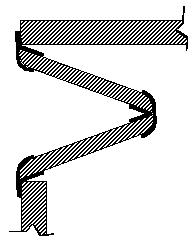 Here
are some pictures and tips for making, or recovering, traditional leather
gusseted organ bellows.
Here
are some pictures and tips for making, or recovering, traditional leather
gusseted organ bellows.
